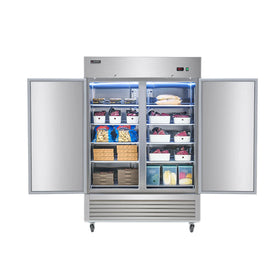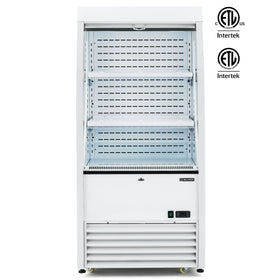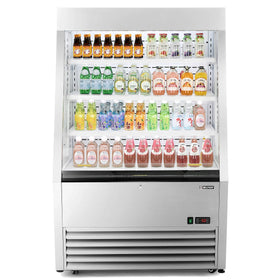Referring to a refrigerator size chart is one of the easiest ways to figure out what size refrigerator best fits your kitchen. If you are in the market for a commercial refrigerator, it is an especially helpful tool for making an informed, efficient purchase.
A complete refrigerator size chart covers types of refrigerators, their typical dimensions, and storage capacity, and is designed to help you compare what size fits best for your professional, private, or even industrial kitchen.
Complete Refrigerator Sizes Chart
| Refrigerator Type | Width | Height | Depth | Capacity (cu ft) | Notes |
| Top Freezer | 28"–33" | 61"–66" | 28"–34" | 14–22 cu ft | Traditional layout, freezer on top, affordable, and space-saving |
| Bottom Freezer | 29"–33" | 67"–70" | 29"–33" | 19–25 cu ft | Easier access to fresh food, less bending |
| Side-by-Side | 32"–39" | 65"–71" | 29"–31" | 20–28 cu ft | Split doors, vertical freezer/fridge, good for narrow door swing space |
| French Door | 29"–36" | 68"–70" | 29"–34" | 20–30 cu ft | Modern, large capacity, bottom freezer, wide shelves |
| Counter-Depth French | 35"–36" | 68"–70" | 24"–27" | 20–23 cu ft | Built-in look, shallower depth to align with cabinets |
| Mini Fridge | 17"–24" | 19"–36" | 18"–26" | 1.5–4.5 cu ft | Compact, ideal for dorms, offices, bedrooms |
| Under-counter Fridge | 23"–24" | 32"–34" | 24" | 4–6 cu ft | Built-in fits under standard countertops, used in bars or kitchens |
| Commercial Reach-In | 27"–54"+ | 78"–84" | 30"–34" | 23–72 cu ft (1–3 doors) | Heavy-duty, stainless steel, for restaurants and commercial kitchens |
If you are in the market for commercial kitchen equipment, you might want to check a commercial refrigerator sizes chart to quickly compare different models and ensure you choose one that:
- Fits your available kitchen space
- Meets your storage capacity needs
- Matches your workflow and food prep style
- Complies with health and safety codes
- Helps avoid over- or under-buying
Commercial Refrigerator Sizes Chart
| Type | Doors | Width | Height | Depth | Capacity (cu ft) | Typical Use |
| Reach-In Refrigerator | 1–3 doors | 27"–81"+ | 78"–84" | 30"–34" | 23–72 cu ft | Kitchens, back-of-house cold storage |
| Undercounter Fridge | 1–3 doors | 27"–72" | 32"–36" | 29"–31" | 6–24 cu ft | Space-saving cold storage under prep tables |
| Worktop Refrigerator | 1–3 doors | 27"–72" | 36"–40" | 30"–32" | 6–24 cu ft | Combines cold storage and food prep surface |
| Glass Door Merchandiser | 1–3 doors | 24"–78"+ | 78"–84" | 29"–32" | 12–72 cu ft | Displaying drinks, snacks, dairy in retail settings |
| Bar Refrigerator | 1–3 doors | 24"–72" | 34"–36" | 24"–29" | 6–25 cu ft | Behind-the-bar bottle and can storage |
| Sandwich/Salad Prep Table | 1–3 doors | 27"–72"+ | 40"–46" | 30"–34" | 6–24 cu ft | Prep station + cold bin storage for toppings |
| Pizza Prep Table | 1–3 doors | 44"–93"+ | 41"–45" | 36"–38" | 15–32 cu ft | Wider cutting surface with refrigerated ingredient wells |
| Chef Base (Refrigerated Equipment Stand) | 2–4 drawers | 36"–96" | 20"–26" | 30"–34" | 4–16 cu ft | Cold storage beneath cooking equipment (griddles, etc.) |
| Work-In Cooler | N/A (walk-in) | 72"–144"+ | 84"–120"+ | 72"–144"+ | 100–1000+ cu ft | Bulk storage for restaurants, hotels, and catering |
Notes
- Width and capacity often vary by manufacturer and door configuration.
- Reach-in refrigerators are often available in single-door, double-door, or triple-door versions.
- Undercounter and prep tables match standard counter heights for integration into kitchens.
- Merchandisers come with swinging or sliding glass doors and interior lighting.

Choosing a Commercial Refrigerator For Your Commercial Kitchen
When choosing the right commercial refrigerator for your commercial kitchen space, think "function first, space second, capacity third".
The right commercial cooler shouldn't just fit your kitchen; it should enhance efficiency, preserve food safely, and save money long term.
Here’s what to consider:
1. Available Space in the Kitchen
Carefully consider the height, width, depth, and door swing of the commercial refrigerator you need and evaluate whether you need under-counter, freestanding, or built-in units based on your layout.
Remember to leave some extra room for:
- Ventilation (usually 2–4 inches clearance)
- Opening doors fully
- Staff movement and workflow
For a small or mid-sized kitchen, you want something like this 27" single-door commercial refrigerator from Wilprep. It offers a volume of 18.7 cu. ft. and a temperature range of 32-50°F, letting you properly store eggs, milk, vegetables, and more fresh produce for your business.
2. Storage Needs & Food Volume
Estimate how much cold storage you need per day or shift. Depending on how busy your commercial kitchen is, you might need about 5-10 times more refrigerator space for a commercial kitchen than a private kitchen.
These questions will help you determine how much refrigerator capacity you need:
- How many ingredients need refrigeration?
- Do you batch-prep or get frequent deliveries?
- Do you need bulk storage (walk-in) or frequent access (reach-in)?
For a small cafe, 1–2 under-counter fridges will do. But if you have a full restaurant, you might need multiple reach-ins or even a walk-in cooler.
Consider this 60" Undercounter Worktop Refrigerator with two doors, with a 14.8 cu. ft. capacity and a temperature range of 32 to 50°F.
It allows you to properly store eggs, milk, & fresh produce while simultaneously preparing your dishes on the worktop and is for medium-sized kitchens.
3. Menu Type and Ingredients
Different types of commercial establishments have different refrigeration needs, so they require different types of commercial refrigerators.
- If you are starting a sandwich shop, you may need commercial prep tables with topping wells.
- A bar requires back-bar refrigerators or glass door coolers for drinks.
- A pizzeria needs commercial pizza prep table refrigerators with wider surfaces and bin space.
- A meat-heavy kitchen may require cold drawers or chef bases under cooking equipment.
4. Door Type and Access Frequency
Consider how often the fridge will be opened/ closed. A commercial refrigerator that will be opened regularly needs fast-recovery compressors and an interior that is easy to clean.
- Glass door merchandisers are great for visibility (but less efficient).
- Solid door units insulate better for back-of-house storage.
- Drawers vs. doors: Drawers are better for batch ingredients; doors suit varied items.
5. Energy Efficiency & Operating Cost
- Commercial fridges can run 24/7, so efficiency matters.
- Look for ENERGY STAR® certified units.
- Pay attention to insulation, door seals, and compressor efficiency.
- Larger units cost more to run, so don’t overbuy on capacity you won’t use.
When it comes to energy efficiency, there is hardly a more reliable mark than a UL-certified mark. Apart from the guaranteed energy efficiency, a UL certification protects food safety in your commercial kitchen in many ways.
7. Compliance & Certification
- Make sure your fridge is NSF-certified (National Sanitation Foundation) for food safety compliance.
- Check local health codes: some areas have specific refrigeration requirements based on food type or prep practices.
Choosing the Right Refrigerator Size
When choosing the right commercial refrigerator size and capacity for your kitchen, it's not just about picking the biggest one; it's about matching the fridge to your operation’s workflow, space, menu, and staff needs.
Check the chart to decide what refrigerator size fits your kitchen space and needs, and make a choice from amongst these affordable options from Wilprep's clearance sale collection.










